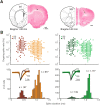Distinct Laterality in Forelimb-Movement Representations of Rat Primary and Secondary Motor Cortical Neurons with Intratelencephalic and Pyramidal Tract Projections
- PMID: 28972128
- PMCID: PMC6596487
- DOI: 10.1523/JNEUROSCI.1188-17.2017
Distinct Laterality in Forelimb-Movement Representations of Rat Primary and Secondary Motor Cortical Neurons with Intratelencephalic and Pyramidal Tract Projections
Abstract
Two distinct motor areas, the primary and secondary motor cortices (M1 and M2), play crucial roles in voluntary movement in rodents. The aim of this study was to characterize the laterality in motor cortical representations of right and left forelimb movements. To achieve this goal, we developed a novel behavioral task, the Right-Left Pedal task, in which a head-restrained male rat manipulates a right or left pedal with the corresponding forelimb. This task enabled us to monitor independent movements of both forelimbs with high spatiotemporal resolution. We observed phasic movement-related neuronal activity (Go-type) and tonic hold-related activity (Hold-type) in isolated unilateral movements. In both M1 and M2, Go-type neurons exhibited bias toward contralateral preference, whereas Hold-type neurons exhibited no bias. The contralateral bias was weaker in M2 than M1. Moreover, we differentiated between intratelencephalic (IT) and pyramidal tract (PT) neurons using optogenetically evoked spike collision in rats expressing channelrhodopsin-2. Even in identified PT and IT neurons, Hold-type neurons exhibited no lateral bias. Go-type PT neurons exhibited bias toward contralateral preference, whereas IT neurons exhibited no bias. Our findings suggest a different laterality of movement representations of M1 and M2, in each of which IT neurons are involved in cooperation of bilateral movements, whereas PT neurons control contralateral movements.SIGNIFICANCE STATEMENT In rodents, the primary and secondary motor cortices (M1 and M2) are involved in voluntary movements via distinct projection neurons: intratelencephalic (IT) neurons and pyramidal tract (PT) neurons. However, it remains unclear whether the two motor cortices (M1 vs M2) and the two classes of projection neurons (IT vs PT) have different laterality of movement representations. We optogenetically identified these neurons and analyzed their functional activity using a novel behavioral task to monitor movements of the right and left forelimbs separately. We found that contralateral bias was reduced in M2 relative to M1, and in IT relative to PT neurons. Our findings suggest that the motor information processing that controls forelimb movement is coordinated by a distinct cell population.
Keywords: channelrhodopsin-2; collison test; contralateral/ipsilateral; cortical hierarchy; pyramidal cell; rat.
Copyright © 2017 the authors 0270-6474/17/3710904-13$15.00/0.
Figures








Similar articles
-
Ipsilateral-Dominant Control of Limb Movements in Rodent Posterior Parietal Cortex.J Neurosci. 2019 Jan 16;39(3):485-502. doi: 10.1523/JNEUROSCI.1584-18.2018. Epub 2018 Nov 26. J Neurosci. 2019. PMID: 30478035 Free PMC article.
-
Layer 5 Intratelencephalic Neurons in the Motor Cortex Stably Encode Skilled Movement.J Neurosci. 2023 Oct 25;43(43):7130-7148. doi: 10.1523/JNEUROSCI.0428-23.2023. Epub 2023 Sep 12. J Neurosci. 2023. PMID: 37699714 Free PMC article.
-
Axonal Barcode Analysis of Pyramidal Tract Projections from Mouse Forelimb M1 and M2.J Neurosci. 2022 Oct 12;42(41):7733-7743. doi: 10.1523/JNEUROSCI.1062-22.2022. Epub 2022 Sep 7. J Neurosci. 2022. PMID: 36414009 Free PMC article.
-
Control of forelimb muscle activity by populations of corticomotoneuronal and rubromotoneuronal cells.Prog Brain Res. 1989;80:437-49; discussion 427-30. doi: 10.1016/s0079-6123(08)62241-4. Prog Brain Res. 1989. PMID: 2517459 Review.
-
Role of the ipsilateral motor cortex in voluntary movement.Can J Neurol Sci. 1997 Nov;24(4):284-91. doi: 10.1017/s0317167100032947. Can J Neurol Sci. 1997. PMID: 9398974 Review.
Cited by
-
Dynamic lateralization in contralateral-projecting corticospinal neurons during motor learning.iScience. 2024 Oct 1;27(11):111078. doi: 10.1016/j.isci.2024.111078. eCollection 2024 Nov 15. iScience. 2024. PMID: 39493873 Free PMC article.
-
Hybrid dedicated and distributed coding in PMd/M1 provides separation and interaction of bilateral arm signals.PLoS Comput Biol. 2021 Nov 22;17(11):e1009615. doi: 10.1371/journal.pcbi.1009615. eCollection 2021 Nov. PLoS Comput Biol. 2021. PMID: 34807905 Free PMC article.
-
Reward expectation enhances action-related activity of nigral dopaminergic and two striatal output pathways.Commun Biol. 2023 Sep 6;6(1):914. doi: 10.1038/s42003-023-05288-x. Commun Biol. 2023. PMID: 37673949 Free PMC article.
-
Rat hippocampal CA1 region represents learning-related action and reward events with shorter latency than the lateral entorhinal cortex.Commun Biol. 2023 May 31;6(1):584. doi: 10.1038/s42003-023-04958-0. Commun Biol. 2023. PMID: 37258700 Free PMC article.
-
Developmental timecourse of aptitude for motor skill learning in mouse.bioRxiv [Preprint]. 2024 Dec 21:2024.07.19.604309. doi: 10.1101/2024.07.19.604309. bioRxiv. 2024. PMID: 39071410 Free PMC article. Preprint.
References
-
- Catsman-Berrevoets CE, Lemon RN, Verburgh CA, Bentivoglio M, Kuypers HG (1980) Absence of callosal collaterals derived from rat corticospinal neurons. Exp Brain Res 39:433–440. - PubMed
Publication types
MeSH terms
Substances
LinkOut - more resources
Full Text Sources
Other Literature Sources
